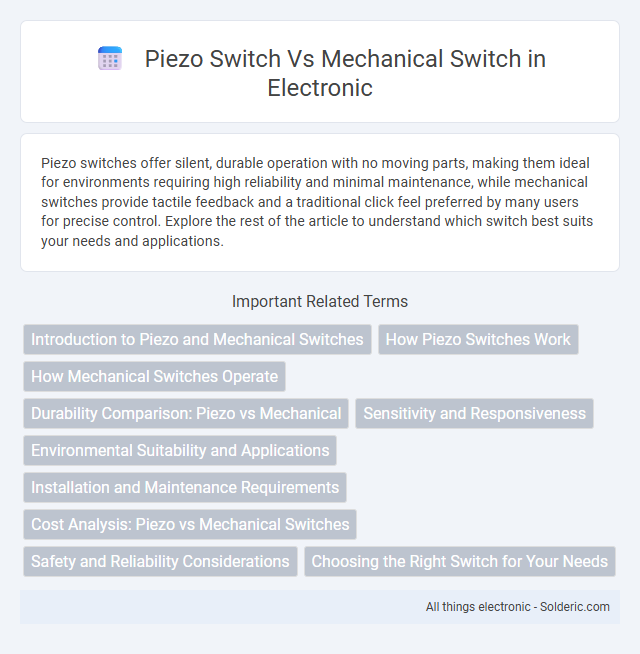Piezo switches offer silent, durable operation with no moving parts, making them ideal for environments requiring high reliability and minimal maintenance, while mechanical switches provide tactile feedback and a traditional click feel preferred by many users for precise control. Explore the rest of the article to understand which switch best suits your needs and applications.
Comparison Table
| Feature | Piezo Switch | Mechanical Switch |
|---|---|---|
| Operating Principle | Uses piezoelectric effect to generate an electric signal | Physical contact closure with moving parts |
| Durability | High, no moving parts, up to 100 million cycles | Moderate, mechanical wear limits lifespan (~1-5 million cycles) |
| Response Time | Fast, milliseconds | Slower due to mechanical movement |
| Environmental Resistance | Superior, resistant to dust, moisture, and vibration | Vulnerable to dust and moisture ingress |
| Force Required | Variable, can detect light touch | Typically higher force to actuate |
| Maintenance | Low, sealed and rugged | Requires periodic cleaning and replacement |
| Cost | Higher initial cost | Generally lower cost |
| Applications | Medical devices, industrial controls, harsh environments | Consumer electronics, keyboards, appliances |
Introduction to Piezo and Mechanical Switches
Piezo switches utilize piezoelectric materials that generate an electrical signal when mechanical pressure is applied, offering high durability and resistance to environmental factors like moisture and dust. Mechanical switches operate through physical contact between conductive components, providing tactile feedback but being more susceptible to wear and mechanical failure over time. Comparative analysis highlights piezo switches as ideal for harsh environments, while mechanical switches are preferred for applications requiring distinct tactile response.
How Piezo Switches Work
Piezo switches operate based on the piezoelectric effect, where applied mechanical pressure generates an electric charge within a ceramic material, enabling contactless switching. Unlike mechanical switches that rely on physical moving parts, piezo switches have no moving components, resulting in higher durability and resistance to wear and environmental factors. Your applications benefit from precise, reliable activation and a longer lifespan due to their solid-state design and minimal maintenance requirements.
How Mechanical Switches Operate
Mechanical switches operate through physical contact between conductive materials, where pressing the switch completes an electrical circuit, allowing current to flow. The movement involves a spring mechanism that provides tactile feedback and resets the switch once released. Your choice of mechanical switches ensures reliable, precise actuation with a distinct audible click, preferred for applications requiring clear user input confirmation.
Durability Comparison: Piezo vs Mechanical
Piezo switches offer superior durability compared to mechanical switches, with lifespans exceeding 100 million actuations due to their solid-state, contactless design that eliminates wear and tear. Mechanical switches rely on physical metal contacts that degrade over time, typically lasting between 1 to 10 million cycles depending on the switch type and quality. The robust construction of piezo switches makes them ideal for harsh environments requiring high reliability and long-term performance.
Sensitivity and Responsiveness
Piezo switches exhibit higher sensitivity and faster responsiveness compared to mechanical switches due to their reliance on pressure-induced electrical charge without the need for physical contact or moving parts. Mechanical switches require physical actuation, which introduces debounce delay and can reduce response time. The solid-state nature of piezo switches allows for precise activation detection and a longer operational lifespan under high-frequency use.
Environmental Suitability and Applications
Piezo switches excel in harsh environments due to their sealed, solid-state design resisting dust, moisture, and vibration, making them ideal for industrial and outdoor applications. Mechanical switches, while reliable in controlled settings, are prone to wear and contamination, limiting their use in rugged or wet conditions. Industries such as automotive, aerospace, and marine prefer piezo switches for durability and low maintenance, whereas mechanical switches remain common in consumer electronics and household devices.
Installation and Maintenance Requirements
Piezo switches require minimal installation effort as they can be surface-mounted without complex mechanical assembly, reducing labor time and risk of component damage. Maintenance demands are significantly lower for piezo switches since they have no moving parts, eliminating wear and tear commonly associated with mechanical switches. Mechanical switches often involve more intricate installation with wiring and physical mounting, and regular maintenance is necessary to address contact degradation and mechanical failures.
Cost Analysis: Piezo vs Mechanical Switches
Piezo switches typically have a higher initial cost compared to mechanical switches due to their advanced materials and solid-state design. Mechanical switches are generally more cost-effective for large-scale production because of their simpler construction and widespread availability. Long-term maintenance expenses favor piezo switches since they have no moving parts, reducing wear and replacement costs over time.
Safety and Reliability Considerations
Piezo switches offer enhanced safety due to their sealed, non-contact design, which eliminates risks of electrical arcs and reduces wear from mechanical movement, ensuring longer reliability in harsh or hazardous environments. Mechanical switches rely on physical contact points that can degrade over time, increasing the chance of failure or sparks in sensitive applications. Choosing a piezo switch can improve your system's durability and operational safety where consistent performance is critical.
Choosing the Right Switch for Your Needs
Piezo switches offer durability and resistance to harsh environments due to their solid-state design, making them ideal for industrial or outdoor applications. Mechanical switches provide tactile feedback and are often preferred for user interfaces requiring physical responsiveness and ease of repair. Selecting the right switch depends on factors like application environment, desired lifespan, feedback preference, and maintenance requirements.
Piezo switch vs mechanical switch Infographic

 solderic.com
solderic.com